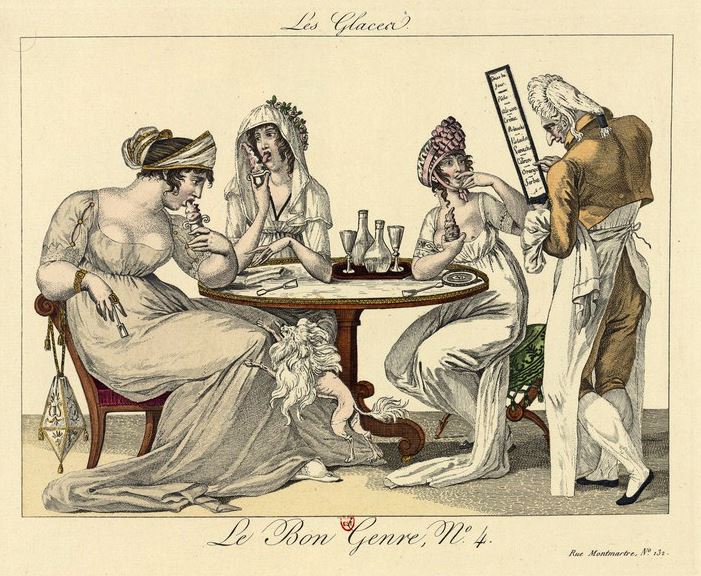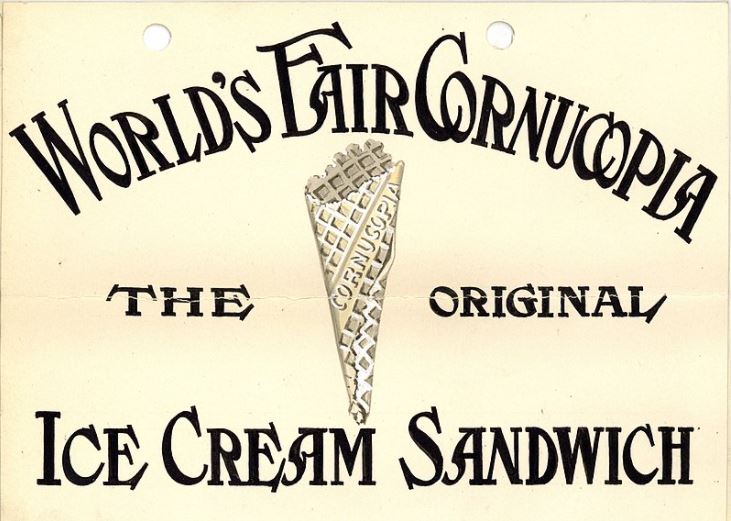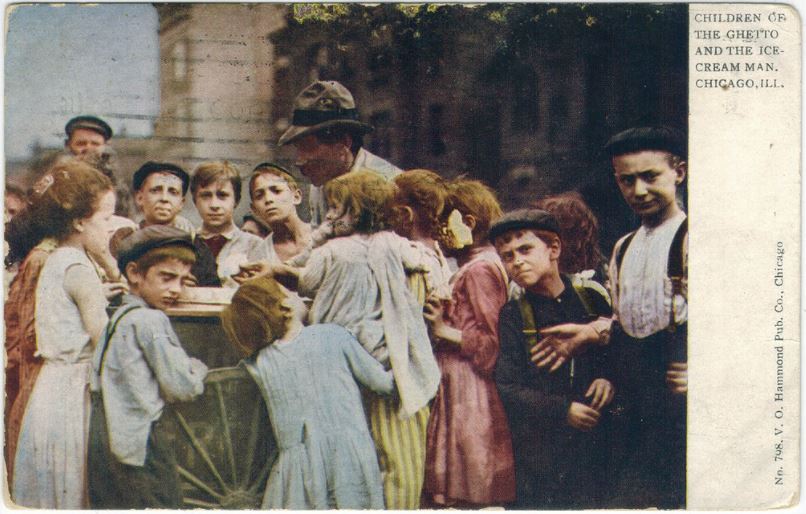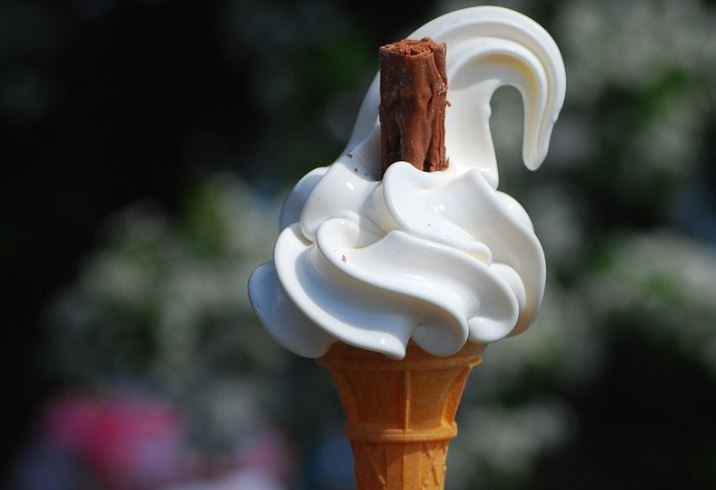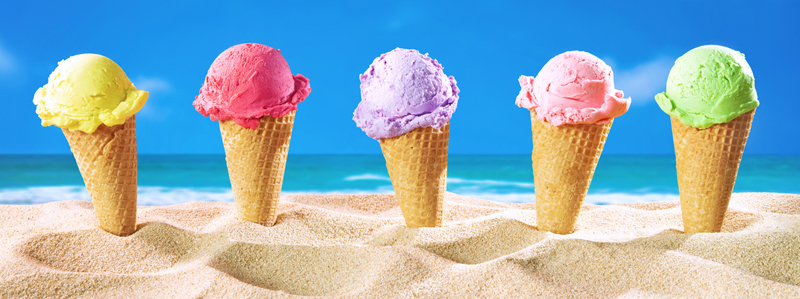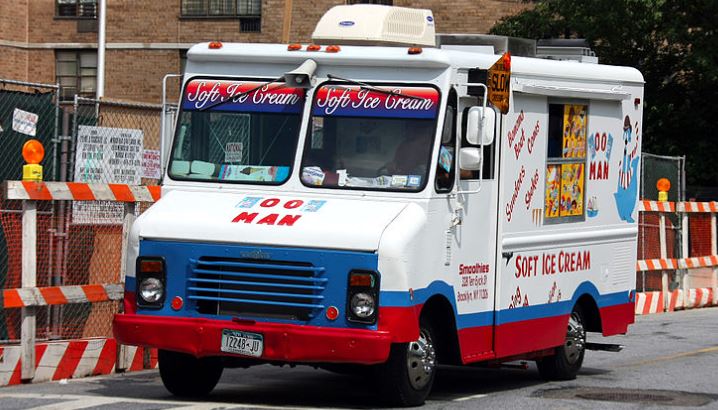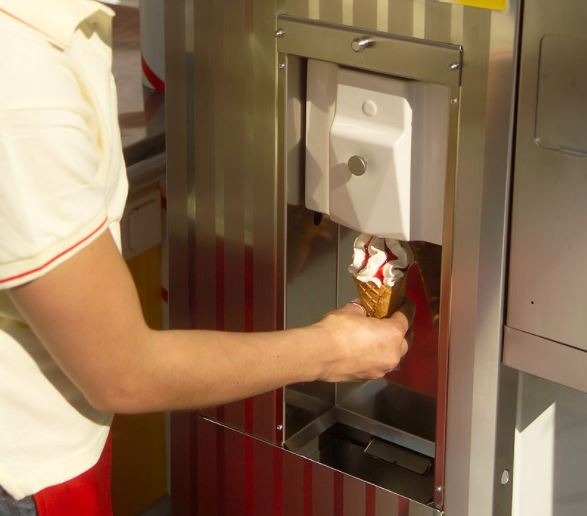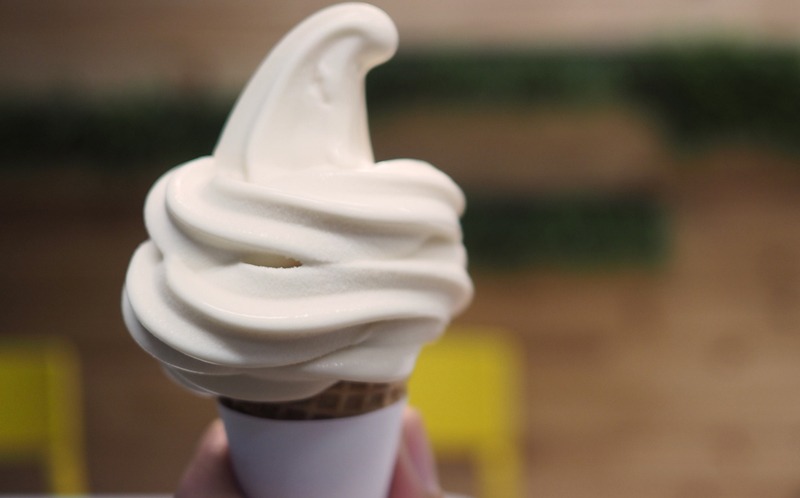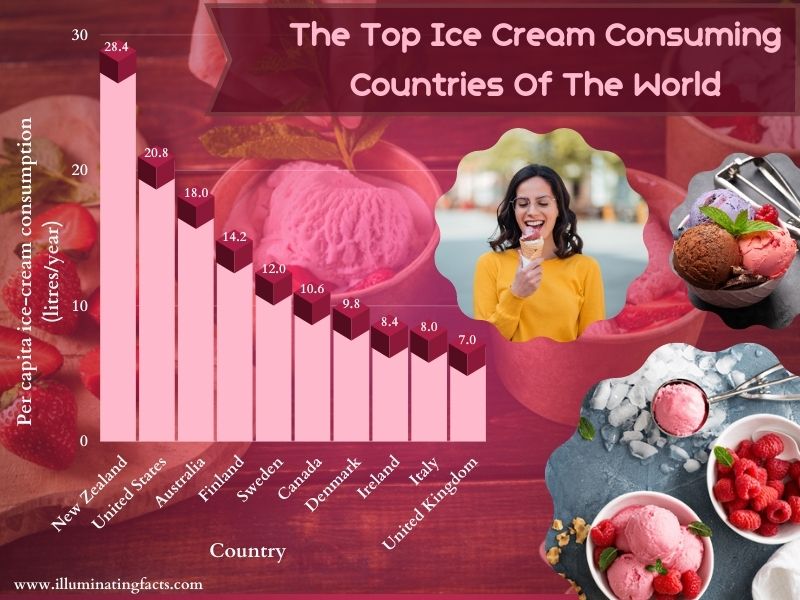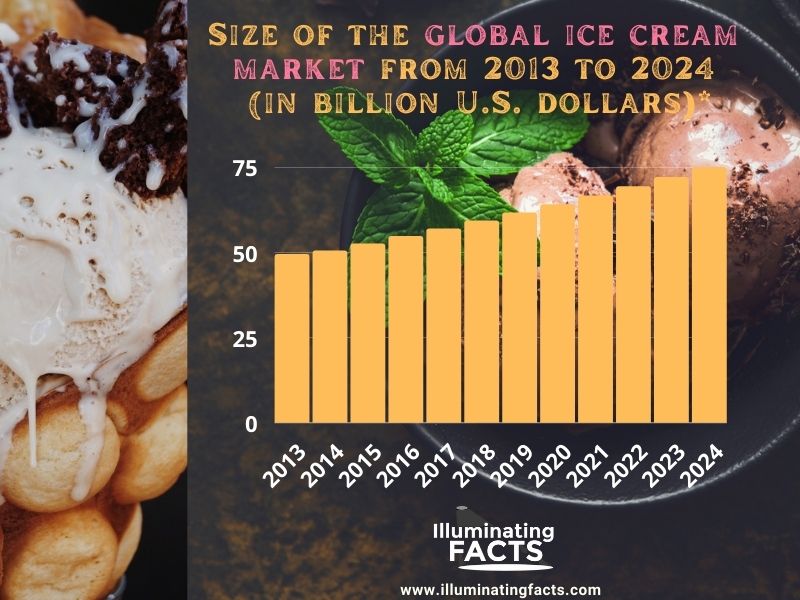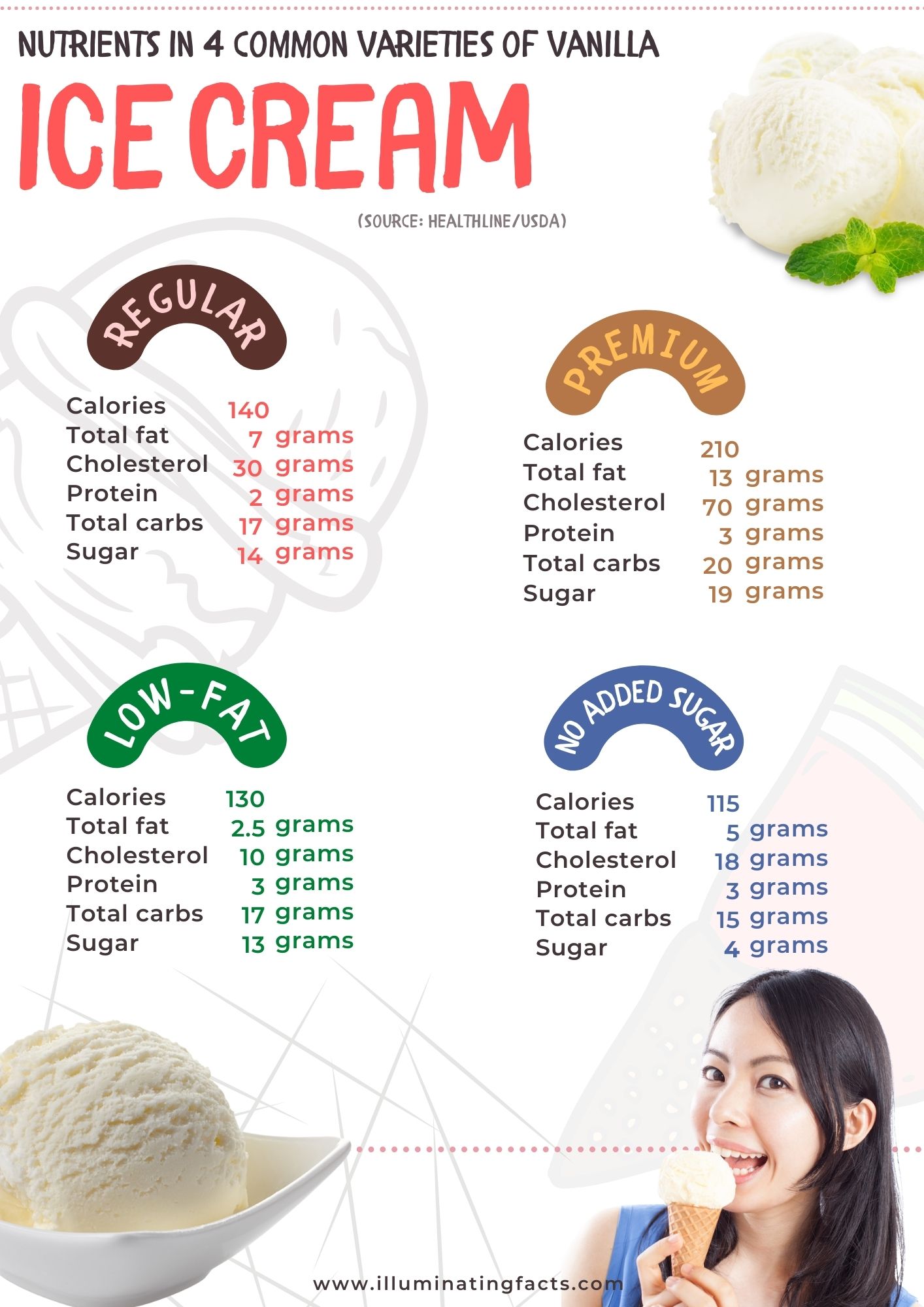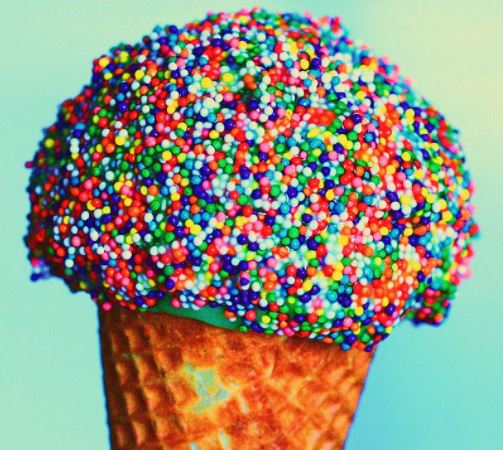BACKGROUND
Ice cream is everybody’s favorite dessert. Undoubtedly, we all crave ice cream at one time or another. Whatever the celebration, ice cream always finds itself on the center stage. This delicious frozen sweet remains a favorite among family and friends. Ice cream sweetens and strengthens the bond during a gathering.
For the children, the sight of ice cream in a cone is always something to behold. The presence of ice cream products never fails to bring out the magic of the moment.

Woman serving ice cream
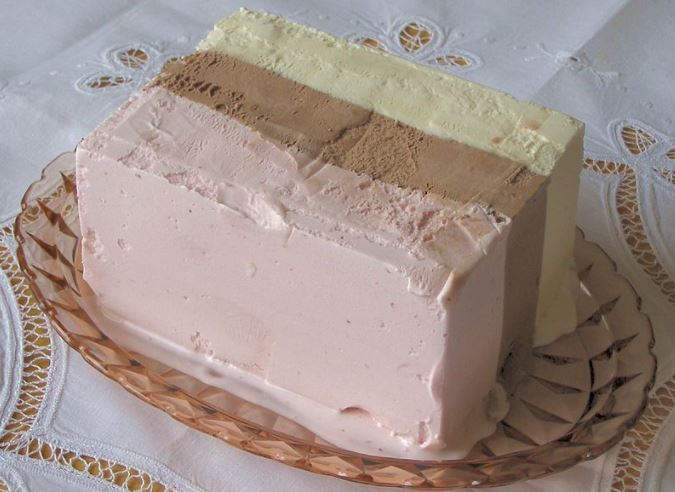
Stracciatella gelato
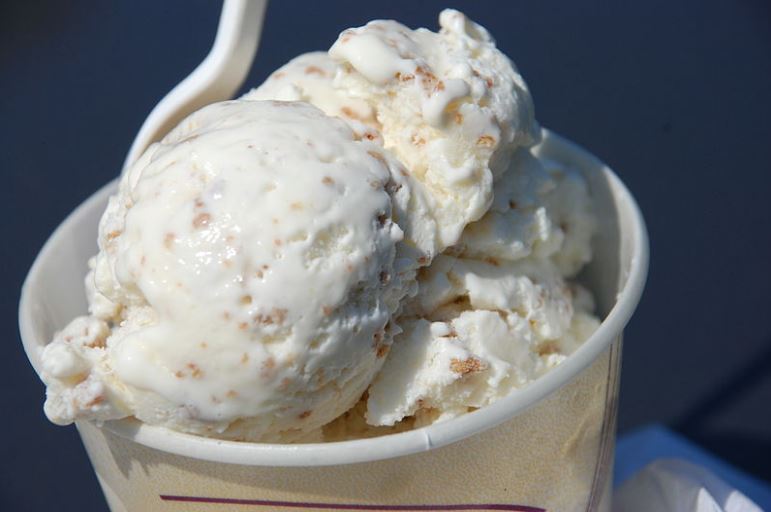
Grape nut ice cream
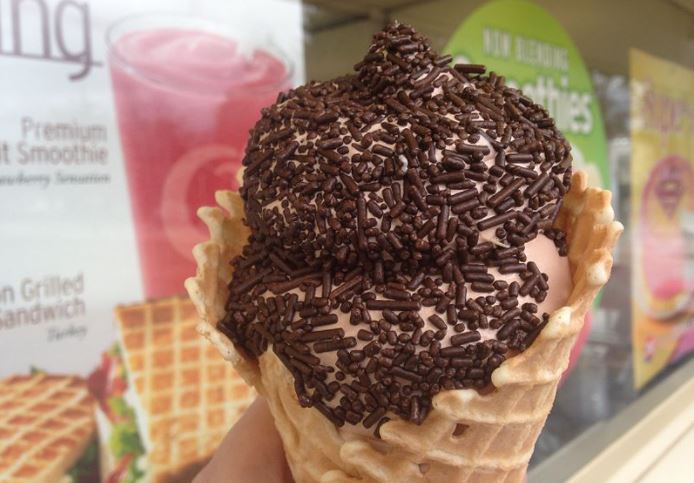
Chocolate soft-serve ice cream
Ice cream is so popular that in 2020 alone, American ice cream makers produced more than over 1 billion gallons of ice cream, up to 6 percent from 2019.
HISTORY
source: Unknown author, Public domain, via Wikimedia Commons
There has been no exact date on when the ice cream was first produced or the specific place where it was made. The person who first discovered the ice cream has yet to be identified.
However, it is widely believed that the origins of ice cream can be traced as far as the second century BC.
Below is the timeline of ice cream, from the olden to the recent ice creams [1]:
500 BC – Persians were the first group of people who started making ice cream. They would put the grape juice concentrate over snow and enjoy eating it during summertime.
400 BC – Persians made ice cream recipes for their royal families. It was made of iced rose water, saffron, fruits, vermicelli, and other sweet flavors.
37-68 BC –Roman Emperor Nero enjoyed chilled delicacies, according to many historians. He had a stock of ice carried from the mountains. The ice was constantly available to him, so he could enjoy his meal with honey toppings and fruit.
200 AD – Old Chinese records showed some stories of a frozen mixture of milk and rice eaten as a delicacy during hot summer.
800- 900 – The Arab people clearly defined the introduction of milk and sugar as basic ingredients of ice cream. This paved the way for the recipe of modern ice cream.
10th century- Baghdad, Damascus, and Cairo, together with the rest of the Arab areas, produced ice cream made of milk, cream, flavored rosewater, dried fruits, and nuts.
1100 – Royal and wealthy families regularly consumed ice-based summer delicacies in China.
Late 13th century – Famous traveler Marco Polo brought the stories and recipe for ice cream making during his return to Italy. The tale made everyone in Italy fascinated about ice cream making from the Middle East and Asia, amid the start of the Renaissance period.
1533 – Ice cream became famous in Italy. The marriage of Catherine de ‘Medici and Henry II of France also helped introduce ice cream to France, and later to the whole of Europe.
1649 – The chef of Charles I of England was beheaded after he broke his oath not to circulate the famous ice cream recipe.
1744 – Scottish colonists brought and introduced ice cream recipes to North America.
1774 –Philip Lenzi, an American caterer, returned from London to New York. This started the ice cream sales.
1813 – Dolly Madison, wife of the U.S. President James Madison, offered ice cream at the presidential Inaugural Ball of 1813.
source: Codepro, CC BY-SA 3.0, via Wikimedia Commons
1846 – Nancy Johnson of New Jersey invented the first hand-cranked and portable freezer.
1851 – Commercial ice cream production started in North America.
1904 – Ice cream demand soared high at St. Louis World’s Fair. The event led to the making of world’s first ice cream cones.
source: Missouri State Archives, No restrictions, via Wikimedia Commons
1926 –The global ice cream industry started after the first commercially viable freezer was created.
1934 –The first chocolate-covered ice cream was known as Eskimo pie.
1939 – The ice cream was mass-produced. The ice cream was made to help boost the morale of Allied soldier in Europe during the war. It was widely thought that Americans invented ice cream.
Second part of 20th century – The start of mass explosion of cheap refrigeration, ice cream brands, and soft ice cream. This made ice cream one of the world’s most favorite summer treats.
ICE CREAM PRODUCTION
Ice cream is mostly produced from March through July. For ice cream producers, the month of July is considered as their busiest production period.
In 2019 alone, more than 6.4 billion pounds of ice cream and frozen yogurt were made in America.
Based on data released by IDFA’s Dairy Delivers, the ice cream industry has a $13.1 billion contribution to the economy of the United States.
source: distillated, CC BY-SA 2.0, via Wikimedia Commons
The ice cream industry paves the way for 28,800 direct jobs and contributed $1.8 billion in direct wages.
Most American ice cream and frozen dessert businesses have been in the ice-making industry for over 50 years. Many of the ice cream companies are family-owned businesses [2].
TOP 10 ICE CREAM FLAVORS IN THE U.S.
- Vanilla
- Chocolate
- Cookies N’ Cream
- Mint Chocolate Chip
- Chocolate Chip Cookie Dough
- Buttered Pecan
- Cookie Dough
- Strawberry
- Moose Tracks
- Neapolitan
According to International Dairy Foods Association (IDFA), premium ice cream is most famous with its consumers, citing data from retailers.
However, for the ice cream makers, the regular ice cream that is commonly sold in stores is the top favorite of the consumers.
For the nut-flavored ice cream, the Pecan is the most popular. In terms of popular fruit flavor, strawberry ice cream is the most favorite among consumers.
On the other hand, chocolate and candy pieces are the most favorite confections in ice cream. For the most popular ice cream containers, topping the list are the waffle cones and sugar cones.
source: Tomás Fano, CC BY-SA 2.0, via Wikimedia Commons
MARKETING OF THE ICE CREAM INDUSTRY
Ice cream retailers’ primary customer group for their marketing targets is the families. The marketing activities are mostly done on a regional or local level.
IDFA said that two-fifths of ice cream producers are looking at an increased demand for premium ice cream versus 17 percent seeing a surge in gelato demand.
source: Lumen GmbH, CC BY-SA 3.0, via Wikimedia Commons
The demand is also followed by 15 percent for sorbet. The low-fat or non-fat ice cream ranked the lowest, with 4 percent demand.
The United States’ most successful ice cream markets are Illinois, Indiana, Michigan, Ohio, and Wisconsin, of the Great Lakes region.
ICE CREAM SALES
In the United States alone, the nation churned out more than 1 billion gallons of ice cream in 2020. The figure is 6 percent up from the 2019 data.
An IRI report indicated that hard ice cream production levels were 4 percent ahead of 2020.
Citing data in 2020, it said that in the first five months of 2021, through the first six months of 2021, retail ice cream sales (grocery) continued to compete. The data said that retail ice cream sales were slightly behind, or -2 percent, the same period from a record 2020 and well above 2019.
The sales of other frozen foods like fudgesicles and ice cream bars were 24 percent ahead from March through May of 2021 of the same period in 2019.
The ice cream market worldwide will reach $91.9 billion in 2027, up from $70.9 billion in 2019, or a 30 percent increase in just less than 10 years following the global demand for ice cream, according to IDFA, citing Fortune Business Insights.
THE WORLD’S TOP ICE CREAM CONSUMING NATIONS
Ice cream has remained one of the top dairy products consumed by people around the globe.
While ice cream has been around for so long, the spike in ice cream demand soared high with the advent of the modern refrigeration system.
The ice cream products are in various features, like frozen yogurt and sorbet. Other ice cream flavors are also manufactured using unconventional flavors [3].
New Zealand is the world’s leading nation in terms of ice cream consumption, with a per capita consumption of 28.4 liters per year. New Zealand is famous for its high standard of making dairy products. The country followed strict and high-quality standards, particularly hygiene.
The country is very innovative in making ice cream products in the market. New Zealand has created ice cream flavors like the hokey pokey. This flavor has become the second most popular in New Zealand after vanilla.
After New Zealand, the United States consumed 20.8 liters of ice cream per capita annually. In 2014 alone, ice cream manufacturers in the United States made more than 872 million gallons of the ice cream product.
Ice cream products in the United States are mainly consumed in the country and exported to Asia, the Caribbean, and Latin America, among other countries.
The most consumed ice cream flavor in the United States is vanilla, followed by a chocolate chip mint.
COMPETITIVE LANDSCAPE IN THE ICE CREAM INDUSTRY
There is stiff competition in the ice cream industry. The competitive market covers regional and global players.
The known competitors in the ice cream industry include Unilever, Nestle, Blue Bell, Herdez, and Inspire Brands Inc.
These companies are inching on each other, particularly on various ice cream product offerings, flavor, price, quality, taste, marketing activities, functionality, size, and packaging.
They are doing these things to get an easy advantage from each other in the market. The most active ice cream makers on the market are mostly focused on coming up with new products to serve the demands or interests of consumers [4].
Major Players in the Ice Cream Industry
- Unilever
- Nestle SA
- General Mills Inc.
- Lotte Corporation
- Inspire Brands, Inc.
source: No machine-readable author provided. Pschemp assumed (based on copyright claims)., CC BY-SA 3.0, via Wikimedia Commons
There is plenty of development in the ice cream market following the surge of demands worldwide.
Like in 2020, Dairy Day, an ice cream brand, came up with Dairy Day Plus, a type of ice cream with immunity-boosting ingredients.
In 2019, Blue Bell Creameries also came up with Key Lime Mango Tart and Mardi Gras King Cake ice cream, plus raspberry fudge brownie flavors, as it aimed to expand its market in the United States.
In 2018, Ben & Jerry’s had an ice cream that features 60-70 percent less fat and 35 percent fewer calories than the traditional ice cream flavors.
TYPES OF ICE CREAM PRODUCTS
There are plenty of ice cream products in the market. Below are the common types of ice cream [5]:
- Regular ice cream – a frozen treat made from a mixture of dairy products containing at least 10 percent milk fat.
- Light or lite ice cream – contains at least 50 percent less total fat or 33 percent fewer calories than the referenced product.
- Low-fat ice cream – contains a maximum of 3 grams of total fat per serving (½ cup).
- Non-fat ice cream– the product has less than 0.5 grams of total fat per serving.
- Frozen Custard or French ice cream – contains a minimum of 10 percent milkfat and at least 1.4 percent egg yolk solids.
- Sherbets – an ice cream product with a milk fat content of between 1 and 2 percent. It weighs a minimum of 6 pounds to the gallon.
- Sorbet and Water Ices – the same as sherbets but do not contain dairy ingredients.
- Frozen Yogurt – the product consists of a mixture of dairy ingredients such as milk and non-fat milk that have been cultured and ingredients for sweetening and flavoring.
source: Joekelsey, CC BY-SA 3.0, via Wikimedia Commons
NUTRITION FACTS OF ICE CREAM PRODUCTS
Ice cream remains a delicious treat to people. Whether cold, sweet, or creamy, ice cream is always inviting, attractive, and irresistible.
However, it is also a fact that ice cream is made of sugar and fat. Thus, it contains lots of calories that would bring risk to our body and health.
There are always potential bad sides to this sweet thing, particularly when you include ice cream in your diet plan.
Generally speaking, the nutritional profile of ice cream differs in terms of brand, flavor, and type [6].
Mainly, premium ice cream contains sugar, fat, and calories. This is because premium ice cream is made to be creamier and richer than regular ice cream.
On the other hand, the low-fat or no-sugar-added ice cream products are mostly introduced as healthier. The product also has the same number of calories as regular ice cream.
Other ice cream products with no added sugar are mostly loaded with sweeteners like sugar alcohols. These sugar alcohols will also impact the person’s health like digestive distress, bloating, and gas.
The majority of the ice cream products contain phosphorus and calcium, giving around 6 and 10 percent of the Daily Value (DV), respectively, per 1/2-cup (65-gram) serving.
source: User DavidLevinson on en.wikipedia, Public domain, via Wikimedia Commons
These types of minerals are good for our healthy muscles and skeletons.
However, the mineral content in the ice cream products doesn’t compensate for the rich calorie and sugar content of the ice cream. See the nutritional value of commercial ice cream and related products
[6].
HEALTH RISK OF ICE CREAM MICROBIAL
Ice cream is a great source for microbial growth as a milk-based product due to its nutrient content, almost neutral pH (pH 6–7), and long storage duration.
The many processes in manufacturing the ice cream can bring microbiological risks.
However, during production, pasteurization, freezing, and hardening steps can destroy health hazards.
Interestingly, the pasteurization of milk can eliminate most pathogens that harm consumers’ health.
The potential microbiological risk can still be found in the final products after pasteurization when added to contaminated ingredients.
Although ice cream is kept at a low (-18C) storage temperature, contamination can occur at different levels.
Thus, it is essential to have enough information on the microbial quality of ice cream before eating it.
The production, transit, and preservation of the ice cream can be the source of contamination. These contaminated products can be a source of food-borne infections in children, older people, and immune-suppressed patients.
Once the ice cream becomes tainted with microbes, the later freezing temperature could not help make the product safer for consumption.
Since ice cream is a perishable dairy product, it is essential to give attention to the handling and aseptic method processing to avoid health issues from contaminated ice cream with pathogenic microorganisms.
In a study by Jadhav (2014), Salmonella species (1- 8 cfu/g) and Shigella 32 species (1- 5 cfu/g) were isolated from some ice cream samples. The research disclosed that around 0% of samples showed Salmonella species, while 53% showed the presence of Shigella species. Based on the review, it can be understood that contamination can happen in ice cream products, although the low temperature is applied to the processing and storage stages [6].
Ratio relationship between total viable bacterial count and E. coli and Staphylococcal density per/ml portion of ice cream samples of different brands | ||||||
Brand | No. of sample analyzed | Average total viable count/ml | Average E. coli count/ml | Ratio of E. coli count : TVC | Average staphylococcal count/ml | Ratio of staphylococcal count : TVC |
Igloo | 3 | 11850 | 9255 | 1: 1.2804 | 2595 | 1: 4.5664 |
Polar | 3 | 13855 | 1136 | 1: 12.1963 | 0 | 1: á |
Kwality | 3 | 8530 | 794 | 1: 10.7430 | 0 | 1: á |
AMAZING FACTS ABOUT ICE CREAM
At first, the ice cream was indeed made from ice, literally speaking. This happened before milk-based ice creams were first introduced many years ago.
The industrial production of ice cream started in the mid-1800s in Boston, United States. The spread of ice cream started when it was delivered to the military troops during World War 2.
The global market then embraced it as a favorite summer food [7].
Here are the other interesting and cool facts about ice cream [8]:
- Sunday is considered the most profitable day for ice cream vendors.
- A total of 12,096 pounds is the weight of the giant ice cream cake.
- In the United States, at least one average person consumes 48 pints of ice cream annually.
- Ninety percent of American households eat ice cream.
- In 1988, the biggest ice cream sundae was created in Edmonton, Alberta, Canada. The ice cream sundae weighed 24 tons.
- The ice cream recipe arrived in North America 250 years after the discovery of Christopher Columbus.
- Vanilla is the most popular flavor of ice cream.
- The ice cream cones were invented during the World’s Fair in St. Louis. A waffle vendor helped in making the cones.
- In Arizona, U.S.A., one of the most unusual ice cream flavors is hot dog-flavored ice cream.
- One dairy cow can produce enough milk for 9,000 gallons of ice cream over her lifetime.
- The United States produces most ice cream in the whole world.
- Historians said Alexander the Great (356-323 BC) liked consuming snow flavored with nectar and honey.
- Hawaii is home to an ice cream bean, a fruit that tastes like vanilla ice cream.
- July is deemed to be National Ice Cream Month in the United States. During wars or recessions, market analysts said that ice cream sales increase many times.
- Chocolate syrup is the most popular ice cream topping.
- One cone of ice cream can be consumed in 50 licks.
- The largest producer of ice cream in the United States is California.
- In 2003 alone, California produced 121 million gallons of ice cream.
- The standard ice cream machines have three levers—one for twisting and two for flavors.
- In 1660, the people in France began eating ice cream openly.
- People celebrated the end of World War II by eating ice cream.
- One cup of vanilla ice cream is packed with 273 calories.
- Ice cream can be produced in many types –frozen custard, ordinary ice cream, frozen yogurt, sherbet, gelato, reduced-fat ice cream, and others.
- Ice cream is often mixed with fruits or other ingredients and flavors. Chocolate was the first flavor of ice cream.
- The ice cream industry in the United States generated over $21 billion.
- The “Brain Freeze” ice cream effect happens when cold ice touches the roof of your mouth, causing blood vessels in the head to dilate.
- William Dreyer of Dreyer’s Ice Cream was believed to be the original maker of Rocky Road in 1929. He partnered with candy maker Joseph Edy, who started the first incarnation of the now-popular flavor in Oakland, California.
- The original American ice cream sundae is made of vanilla ice cream with flavored sauce or chocolate syrup on the top. It has whipped cream and a single maraschino cherry.
- Neapolitan ice cream has three layers, each of a different flavor and color. Chocolate, strawberry, and vanilla are molded into a block and cut into slices.
- Neapolitan flavored ice cream came from the Italian city of Naples in the late 19th century.
- Heladería Coromoto, or Coromoto, is a popular ice cream parlor in Merida, Venezuela. It was famous for 860 flavors, earning it a place in the Guinness World Record.
- Ice cream was first known as a high-end luxury, especially for special events.
- Emperor Nero was said to have liked lemon sorbet combined with raspberries and rose water.
- In the Victorian era, people started using elaborate presses using milk and ingredients like cream, butterfat, and milk.
- The first documented ice cream sundae was made on Sunday, April 3, 1892.
- King Charles I of England paid his chef £500 annually to keep his ice cream recipe a secret from the public.
- Nancy Johnson invented the ice cream-making machine in 1843. The machine changed the world of ice cream production.
- Russia’s Catherine the Great loved ice cream that she had her own porcelain ice cream serving sets.
- The ice cream cone was invented purely by accident.
- An ice-cream-like delicacy was first eaten in China in 618-97AD by King Tang of the Shang Dynasty.
- In 1565, Bernardo Buontalenti invented a refrigeration technique that made the people in Italy consume ice cream at any time.
- Ice cream sellers introduced ice cream sundaes to boost their sales when religious scholars prohibited eating ice cream sodas on Sundays in many states in America.
-
- During the 1600s, the first ice cream dessert in Italy was invented.
- The United States President Thomas Jefferson introduced the vanilla flavor to the American market after visiting France.
- Miki Sudo became a world-record holder when he ate 16.5 pints of ice cream in 6 minutes.
- Ice cream trucks can only play musical tunes between 12-7 pm in the United Kingdom.
- There are over 1,000 independent artisan ice cream stores in the United Kingdom and Ireland.
- Bassets is the oldest ice cream producer in the United States. It was established in 1861.
- In 1984, United States President Ronald Reagan designated the month of July as National ice cream month. He also made the third Sunday of the month National ice cream day.
- In the United Kingdom, it is very common to eat ice cream with a chocolate flake, known as a 99 Flake.
- According to NASA, ice cream is one of the top 3 foods astronauts miss the most.
- Gelato is the name of ice cream in Italy.
- Throughout the summer of 1790, United States President George Washington spent about $200 on ice cream.
- In Victorian England, the ice cream from street vendors was known as a penny lick.
- Mr. Harry Burt became the first ice cream vendor who appeared in 1920.
-
- The ideal temperature to serve ice cream is between 8-10F.
- Ice creamery is a place where ice cream is produced.
- More ice cream is sold on Sundays than any other day of the week.
- Professional ice cream tasters use golden spoons, so the metal doesn’t impact the taste of the ice cream.
- The fat content of ice cream is 7.26g of fat in a regular serving.
- Nine percent of milk produced in the whole of the United States is used to make ice cream.
- About 50 percent of the volume in ice cream is air. This is why ice cream has a light texture.
- The United States is among the top 3 nations with the highest ice cream consumption and sales.
- A Ben and Jerry waffle cone has an average of 259 little squares.
- Ben and Jerry’s also sold crepes, soup, and pottery besides ice cream.
- The world’s tallest ice cream was more than 9 feet tall.
- There are plenty of dairy-free options for making ice cream products.
- The world’s largest ice cream cake weighed 12,096 pounds.
- There are more than 1,000 ice cream flavors in the world.
- Marco Polo introduced ice cream in continental Europe when he returned to Italy with his travel stories in China.
- A study found that those who consume ice cream in the morning remain more alert than those who don’t eat ice cream at all.
REFERENCES
[1] Ice Cream History.net. Timeline of Ice Cream – From Ancient to Modern Ice Creams. Available at http://www.icecreamhistory.net/frozen-dessert-history/ice-cream-timeline/ [Accessed November 22, 2021].
[2] IDFA.org. Ice Cream Sales & Trends. Available at
https://www.idfa.org/ice-cream-sales-trends [Accessed November 19, 2021].
[3] World Atlas.com. Which Country Eats The Most Ice Cream? Available at https://www.worldatlas.com/articles/the-top-ice-cream-consuming-countries-of-the-world.html [Accessed November 23, 2021].
[4] Mordor Intelligence.com. Ice cream Market – Growth, Trends, Covid-19 Impact, and Forecasts (2021 – 2026). Available at
https://www.mordorintelligence.com/industry-reports/ice-cream-market [Accessed November 23, 2021].
[5] Health Line.com. Is Ice Cream Good for You? Nutrition Facts and More. Available at https://www.healthline.com/nutrition/ice-cream
[6] Ommega Online.org. Ice Cream Nutrition and Its Health Impacts. Available at https://www.ommegaonline.org/article-details/Ice-Cream-Nutrition-and-Its-Health-Impacts/2678 [Accessed November 25, 2021].
[7] Ice Cream History.net. Facts about Ice Cream. Available at http://www.icecreamhistory.net/ice-cream-facts/interesting-facts-about-ice-cream/ [Accessed November 25, 2021].
[8] Kidadl.com. 65 Ice Cream Facts That Are Seriously Cool, 2021. Available at https://kidadl.com/articles/ice-cream-facts-that-are-seriously-cool [Accessed November 26, 2021].



